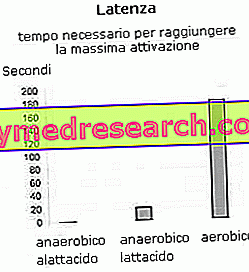AEROBIC RESISTANCE | Aerobic effort requires optimization of transport and use of oxygen; this gas is in fact exploited by the cells to oxidize the energy substrates (such as carbohydrates and lipids) and produce ATP. |
Aerobic metabolism is the main energy production route, but has the major limitation of taking time to reach full activation (about a couple of minutes); the maximum amount of energy produced per unit of time is also limited (20 Kcal / minute approx.). Consequently, aerobic resistance is very important if the effort required exceeds two minutes.

Generally speaking, aerobic endurance depends on many factors, including:
Aerobic endurance can be further divided into: short-term aerobic resistance : from 2 to 8 minutes (also involves the anaerobic lactate system); medium duration aerobic resistance : from 8 to 30 minutes (mainly involves the aerobic system); long-lasting aerobic endurance : from 30 minutes upwards (almost exclusively involving the aerobic system). | |||||||||||||||||||||||||||||||||||||
ANAEROBIC RESISTANCE
| Anaerobic means "in the absence of oxygen". With reference to resistance, this term is used to emphasize the use of a metabolic pathway that produces energy regardless of the presence of this gas. The anaerobic emergency system comes into operation when the energy demand exceeds the body's maximum capacity to produce it, making an extra share of ATP available. Compared to the previous one, it has a lower latency (it is activated massively in a few moments) and a greater power (it produces more energy in the unit of time). However, the anerobic system has the major limitation of producing a toxic catabolite, lactic acid (whose accumulation limits the ability to contract muscle causing fatigue) and to quickly exhaust energy substrates. As a result, anaerobic resistance is important in efforts lasting less than two minutes. Link to learn more: energy metabolism and energy metabolism in muscular work. | ||||||||||||||||||||||||||||||||||||
Similarly to what was seen for aerobic resistance, the anaerobic resistance can be further divided into: anaerobic resistance of short duration : less than 15 seconds (massively involves the anaerobic alactacid system); anaerobic resistance of medium duration : from 15 to 60 seconds (mainly involves the anaerobic lactate system); long-term anaerobic resistance : from 60 to 120 seconds (involving the lactate anaerobic system and partly the aerobic one). | |||||||||||||||||||||||||||||||||||||



